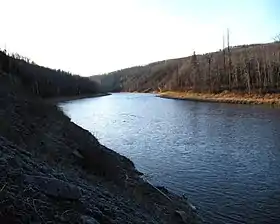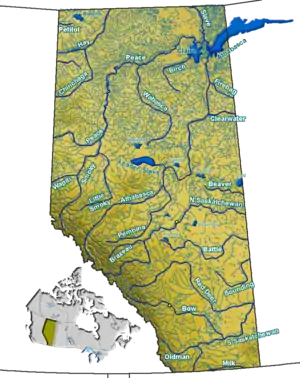| Christina River | |
|---|---|
 The Christine River in late Autumn, near its confluence with the Clearwater River. | |
| Location | |
| Country | Canada |
| Province | Alberta |
| Physical characteristics | |
| Source | Christina Lake |
| • location | 55°37′21″N 110°52′42″W / 55.62250°N 110.87833°W, Wood Buffalo, Alberta, Canada |
| 2nd source | |
| • location | west |
| Source confluence | Jackfish River |
| Mouth | Clearwater River |
The Christina River is located in the Wood Buffalo region of north-eastern Alberta, Canada. The Christina is a tributary of the Clearwater River and was named to honour Christine Gordon, who was the first white women to live permanently in the Fort McMurray area.[1][2][3][4]
Course and drainage basin
The Christina River arises close to Christina Lake near the town of Conklin and is part of Christina Lake's 1,250-square-kilometre (480 sq mi) drainage basin.[3] Christina Lake's waters reach the Christina River via the short (11 kilometres (7 mi) long) Jackfish River. The Christina then wanders northward for about 110 kilometres (68 mi) to join the Clearwater River about 16 kilometres (10 mi) east of Fort McMurray.[5] The waters eventually reach the Arctic Ocean via the Athabasca and MacKenzie Rivers.
History
The Christina River and Christina Lake were named to honour Christine Gordon, originally from Scotland, who was the first white woman to live permanently in the Fort McMurray area, where she remained until her death in the 1940s. She was highly respected by the community, including the First Nations and Métis.[6] Gordon, partly based on knowledge gleaned from a Scottish home nursing book, made her own treatments for illnesses and injuries. She could "splint a broken arm, lower a fever, and mix herbal remedies." By 1914 she owned and operated a post in Fort McMurray, in competition with the Hudson's Bay Company.[1][2][3][4]
Notes
See also
References
- 1 2 Eric J. Holmgren; Patricia M. Holmgren. 2,000 Place-names of Alberta (3 ed.). Saskatoon, Saskatchewan: Western Producer Prairie Books.
- 1 2 "Fort McMurray Before the Hospital". The Catholic Mission: The South of the North Pioneers. Fort McMurray, Alberta: Heritage Park. Retrieved 14 June 2013.
- 1 2 3 "Christina Lake". Atlas of Alberta Lakes. Department of Biological Sciences, University of Alberta. 2004–2005. Archived from the original on 14 March 2012. Retrieved 14 June 2013.
- 1 2 Irwin Huberman (2004). The Place We Call Home: A History of Fort McMurray As Its People Remember. Fort McMurray: Historical Book Society of Fort McMurray. p. 284. ISBN 0968933904. Retrieved 14 June 2013.
- ↑ Canada Department of Energy, Mines and Resources, 1991 and 1993. National Topographic System maps 73M (Winefred Lake) and 74D (Fort McMurray), scale 1:250,000.
- ↑ Integrated Resource Plan - Christina Lake Management Plan (PDF) (Report). Land Use Planning. SRD Government of Alberta. 1991. Archived from the original (PDF) on 4 June 2013. Retrieved 14 June 2013.
